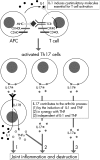Potential new targets in arthritis therapy: interleukin (IL)-17 and its relation to tumour necrosis factor and IL-1 in experimental arthritis
- PMID: 17038468
- PMCID: PMC1798387
- DOI: 10.1136/ard.2006.058529
Potential new targets in arthritis therapy: interleukin (IL)-17 and its relation to tumour necrosis factor and IL-1 in experimental arthritis
Abstract
Rheumatoid arthritis (RA) is a systemic autoimmune disease characterised by chronic joint inflammation and destruction. Interleukin (IL)-17 is a T cell cytokine expressed in the synovium and synovial fluid of patients with RA. IL-17 is a potent inducer of various cytokines such as tumour necrosis factor (TNF) and IL-1. IL-17 has been shown to have additive or even synergistic effects with TNF and IL-1 during the induction of cytokine expression and joint damage in vitro and in vivo. TNFalpha and IL-1 are considered powerful targets in the treatment of RA because of their leading role in driving the enhanced production of cytokines, chemokines, and degradative enzymes. Besides anti-TNF and anti-IL-1 therapies, whose clinical efficacy is now established, new targets have been proposed for RA which is not responding to conventional treatments. This paper discusses the role of IL-17 in experimental arthritis and its interrelationship with TNF and IL-1, currently the most targeted cytokines in the treatment of RA. IL-17 is involved in both initiation and progression of murine experimental arthritis. Studies have shown that IL-17 not only synergises with TNF, but also enhances inflammation and destruction independent of IL-1 and TNF. On the basis of these studies, the authors propose IL-17 as an interesting additional target in the treatment of RA.
Conflict of interest statement
Competing interests: none declared
Similar articles
-
Protection against cartilage and bone destruction by systemic interleukin-4 treatment in established murine type II collagen-induced arthritis.Arthritis Res. 1999;1(1):81-91. doi: 10.1186/ar14. Epub 1999 Oct 26. Arthritis Res. 1999. PMID: 11056663 Free PMC article.
-
The role of T-cell interleukin-17 in conducting destructive arthritis: lessons from animal models.Arthritis Res Ther. 2005;7(1):29-37. doi: 10.1186/ar1478. Epub 2004 Nov 30. Arthritis Res Ther. 2005. PMID: 15642151 Free PMC article. Review.
-
Treatment with a neutralizing anti-murine interleukin-17 antibody after the onset of collagen-induced arthritis reduces joint inflammation, cartilage destruction, and bone erosion.Arthritis Rheum. 2004 Feb;50(2):650-9. doi: 10.1002/art.20001. Arthritis Rheum. 2004. PMID: 14872510
-
Combined inhibition of tumor necrosis factor α and interleukin-17 as a therapeutic opportunity in rheumatoid arthritis: development and characterization of a novel bispecific antibody.Arthritis Rheumatol. 2015 Jan;67(1):51-62. doi: 10.1002/art.38896. Arthritis Rheumatol. 2015. PMID: 25303306
-
Anti-cytokine therapy in chronic destructive arthritis.Arthritis Res. 2001;3(1):18-26. doi: 10.1186/ar136. Epub 2000 Nov 10. Arthritis Res. 2001. PMID: 11178124 Free PMC article. Review.
Cited by
-
Human cathelicidin LL-37 and its derivative IG-19 regulate interleukin-32-induced inflammation.Immunology. 2014 Sep;143(1):68-80. doi: 10.1111/imm.12291. Immunology. 2014. PMID: 24666281 Free PMC article.
-
KSR1 protects from interleukin-10 deficiency-induced colitis in mice by suppressing T-lymphocyte interferon-γ production.Gastroenterology. 2011 Jan;140(1):265-74. doi: 10.1053/j.gastro.2010.09.041. Epub 2010 Sep 25. Gastroenterology. 2011. PMID: 20875416 Free PMC article.
-
The Role of IL-17 in the Association between Pneumococcal Pneumonia and Allergic Sensitization.Int J Microbiol. 2011;2011:709509. doi: 10.1155/2011/709509. Epub 2011 Nov 17. Int J Microbiol. 2011. PMID: 22164165 Free PMC article.
-
ICOS promotes IL-17 synthesis in colonic intraepithelial lymphocytes in IL-10-/- mice.J Leukoc Biol. 2010 Feb;87(2):301-8. doi: 10.1189/jlb.0409238. Epub 2009 Nov 4. J Leukoc Biol. 2010. PMID: 19889730 Free PMC article.
-
Altered kinetics of interleukin-6 and other inflammatory mediators during exercise in children with type 1 diabetes.J Investig Med. 2008 Apr;56(4):701-13. doi: 10.2310/JIM.0b013e31816c0fba. J Investig Med. 2008. PMID: 18382266 Free PMC article.
References
Publication types
MeSH terms
Substances
LinkOut - more resources
Full Text Sources
Other Literature Sources






